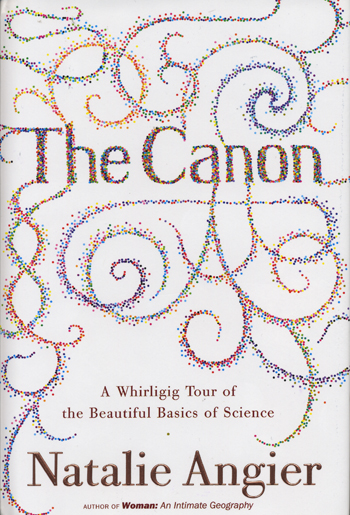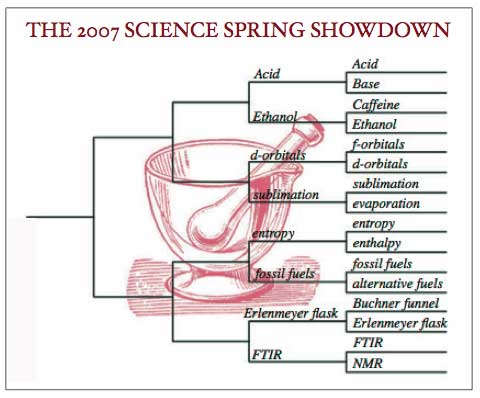
The average American’s lack of scientific literacy has become a common complaint, not only among scientists but also among those who see our economic prospects as a nation linked to our level of scientific know-how. Yet somehow, science has become an area of learning where it’s socially acceptable to plead ignorance. Adults leave the house without even a cocktail-party grasp of the basics they presumably learned in middle school and high school science classes, and the prospects of herding them back into a science classroom to give it another go seem pretty remote.
Natalie Angier’s new book The Canon seeks to provide an audience of adults with the central ideas in physics, chemistry, biology, geology, and astronomy, as well as a reasonable handle on the activity of science more generally. Angier is not presenting a textbook for a survey course, but rather a taste of how these different scientific disciplines understand various chunks of the world we live in. The audience she is trying to reach may fear science, or remember it as boring, or have no good story about how it connects with everyday life. Angier is relentless in identifying science as it crosses our paths, and it is clear that she is taken with the beauty in the scientists’ accounts of their phenomena. What is less clear is whether Angier’s rhapsody to science will really engage her intended audience.
Category Archives: Basic concepts
Basic concepts: refrigeration.
My last post for the basic concepts series involved phases of matter and transformations from one phase to another. This post will look at how a phase change can be put to practical use in a common household appliance — the freezer. My aim here is to give you a good thermodynamic feel for how a freezer works. As a bonus, I’ll explain why leaving the freezer door open is a futile strategy for cooling down a hot kitchen.
Basic concepts: phase changes.
Some months ago I made a (seemingly idle) threat to follow up my basic concepts posts on polar and non-polar molecules and intermolecular forces with a post on phase changes. Finally it’s here!
Since the discussion here will be leaning on a number of the concepts discusses in the earlier posts, don’t be afraid to click back to them to re-read any of the parts that seem rusty.
2007 Science Spring Showdown: Kuhn vs. Theory coverage!
PRESS CENTER | UPDATED BRACKET
Janet: Welcome to team coverage of the much anticipated Chair Bracket match between Kuhn and Theory!
Ben: Yes, I think we can agree on our assumptions that this will be quite a battle.
Janet: I certainly hope so, Ben. Otherwise, we’re going to spend the whole game talking past each other!
Another expert weighs in on chemistry matches in the Sweet Sixteen.
The pregame show has already started on the Acid vs d-orbitals game, but we’ve just received another set of predictions about this game and the Fossil Fuels vs. Erlenmeyer Flask match (hmm, should I say “match” there?) from the Molecule of the Day guy. Adjust your best accordingly!
Science Spring Showdown Sweet Sixteen: Game venues announced!
You’ve been waiting patiently. It’s almost here!
2007 Science Spring Showdown: Experts handicap the third round chemistry matches.
As we head into the Science Spring Showdown Sweet Sixteen, it seemed prudent to turn to some experts for their predictions on the two remaining games in the chemistry region, Acid vs. d-orbitals and Fossil fuels vs. Erlenmeyer flask. (Of course, we won’t soon forget the exciting first and second round games that brought these four teams to the Sweet Sixteen.)
Here’s what some members of the chemical cognoscenti have to say:
Chemistry round two: results for MORTAR AND PESTLE bracket announced!
1st ROUND RESULTS | PRESS CENTER | PRINTABLE BRACKETS

Welcome to coverage of the 2007 Science Spring Showdown second round play in the Chemistry region. The fans in Chemical Arena resorted to a face centered cubic strategy to pack themselves into the stands. You could almost feel the electricity in the air as the products of the first round match-ups were poured into the separatory funnel of the second round. The fans and the teams shook things up. Which teams came out in the top layer, and which saw their hopes of going all the way drained out?
Chemistry fans get excited as second round games in MORTAR AND PESTLE bracket draw near.
PRESS CENTER | PRINTABLE BRACKETS

Even given a weekend to come back to equilibrium, some chemistry fans are still perturbed by some of the results of first round play in the MORTAR AND PESTLE bracket. FTIR’s upset win over NMR has many a Monday morning spectroscopist splitting his peaks trying to analyze what went wrong. And while Ethanol is a perennial powerhouse in this conference, many tournament watchers had anticipated celebrating Caffeine at their Monday morning lab meetings.
Friday’s games were just the first step in a mutli-step synthesis of a tournament champion. Tomorrow, just four teams will emerge from the crucible of second round play in the Chemical Arena. The match-ups will be:
Chemistry Conference first round results!
PRESS CENTER | PRINTABLE BRACKETS
The March weather in California has taken a turn for the beautiful this afternoon, but to chemistry conference fans, the natural beauty of the great outdoors is no match for the beauty of the competitions inside the Chemical Arena. The crowds donned their safety goggles and souvenir nitrile gloves and piled in to observe the action. The press box was a flurry of strip-charts and lab notebooks. After some excited play, here are the first round results:
